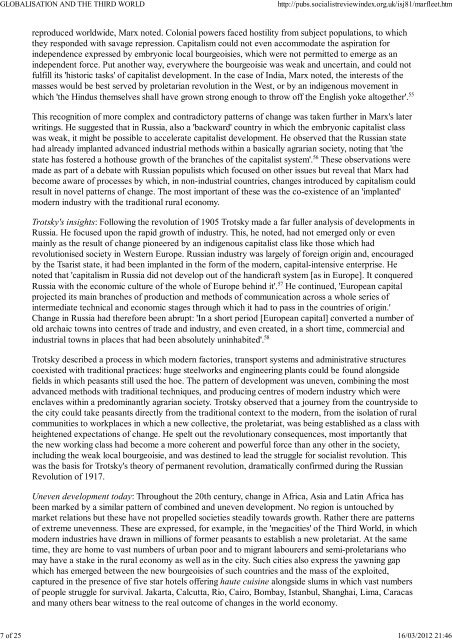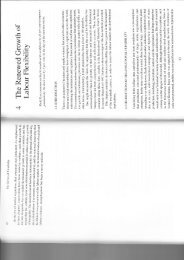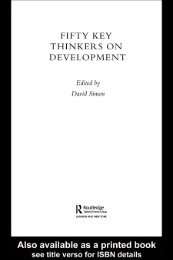GLOBALISATION AND THE THIRD WORLD.pdf - Steerweb.org
GLOBALISATION AND THE THIRD WORLD.pdf - Steerweb.org
GLOBALISATION AND THE THIRD WORLD.pdf - Steerweb.org
Create successful ePaper yourself
Turn your PDF publications into a flip-book with our unique Google optimized e-Paper software.
<strong>GLOBALISATION</strong> <strong>AND</strong> <strong>THE</strong> <strong>THIRD</strong> <strong>WORLD</strong>http://pubs.socialistreviewindex.<strong>org</strong>.uk/isj81/marfleet.htm7 of 25 16/03/2012 21:46reproduced worldwide, Marx noted. Colonial powers faced hostility from subject populations, to whichthey responded with savage repression. Capitalism could not even accommodate the aspiration forindependence expressed by embryonic local bourgeoisies, which were not permitted to emerge as anindependent force. Put another way, everywhere the bourgeoisie was weak and uncertain, and could notfulfill its 'historic tasks' of capitalist development. In the case of India, Marx noted, the interests of themasses would be best served by proletarian revolution in the West, or by an indigenous movement inwhich 'the Hindus themselves shall have grown strong enough to throw off the English yoke altogether'. 55This recognition of more complex and contradictory patterns of change was taken further in Marx's laterwritings. He suggested that in Russia, also a 'backward' country in which the embryonic capitalist classwas weak, it might be possible to accelerate capitalist development. He observed that the Russian statehad already implanted advanced industrial methods within a basically agrarian society, noting that 'thestate has fostered a hothouse growth of the branches of the capitalist system'. 56 These observations weremade as part of a debate with Russian populists which focused on other issues but reveal that Marx hadbecome aware of processes by which, in non-industrial countries, changes introduced by capitalism couldresult in novel patterns of change. The most important of these was the co-existence of an 'implanted'modern industry with the traditional rural economy.Trotsky's insights: Following the revolution of 1905 Trotsky made a far fuller analysis of developments inRussia. He focused upon the rapid growth of industry. This, he noted, had not emerged only or evenmainly as the result of change pioneered by an indigenous capitalist class like those which hadrevolutionised society in Western Europe. Russian industry was largely of foreign origin and, encouragedby the Tsarist state, it had been implanted in the form of the modern, capital-intensive enterprise. Henoted that 'capitalism in Russia did not develop out of the handicraft system [as in Europe]. It conqueredRussia with the economic culture of the whole of Europe behind it'. 57 He continued, 'European capitalprojected its main branches of production and methods of communication across a whole series ofintermediate technical and economic stages through which it had to pass in the countries of origin.'Change in Russia had therefore been abrupt: 'In a short period [European capital] converted a number ofold archaic towns into centres of trade and industry, and even created, in a short time, commercial andindustrial towns in places that had been absolutely uninhabited'. 58Trotsky described a process in which modern factories, transport systems and administrative structurescoexisted with traditional practices: huge steelworks and engineering plants could be found alongsidefields in which peasants still used the hoe. The pattern of development was uneven, combining the mostadvanced methods with traditional techniques, and producing centres of modern industry which wereenclaves within a predominantly agrarian society. Trotsky observed that a journey from the countryside tothe city could take peasants directly from the traditional context to the modern, from the isolation of ruralcommunities to workplaces in which a new collective, the proletariat, was being established as a class withheightened expectations of change. He spelt out the revolutionary consequences, most importantly thatthe new working class had become a more coherent and powerful force than any other in the society,including the weak local bourgeoisie, and was destined to lead the struggle for socialist revolution. Thiswas the basis for Trotsky's theory of permanent revolution, dramatically confirmed during the RussianRevolution of 1917.Uneven development today: Throughout the 20th century, change in Africa, Asia and Latin Africa hasbeen marked by a similar pattern of combined and uneven development. No region is untouched bymarket relations but these have not propelled societies steadily towards growth. Rather there are patternsof extreme unevenness. These are expressed, for example, in the 'megacities' of the Third World, in whichmodern industries have drawn in millions of former peasants to establish a new proletariat. At the sametime, they are home to vast numbers of urban poor and to migrant labourers and semi-proletarians whomay have a stake in the rural economy as well as in the city. Such cities also express the yawning gapwhich has emerged between the new bourgeoisies of such countries and the mass of the exploited,captured in the presence of five star hotels offering haute cuisine alongside slums in which vast numbersof people struggle for survival. Jakarta, Calcutta, Rio, Cairo, Bombay, Istanbul, Shanghai, Lima, Caracasand many others bear witness to the real outcome of changes in the world economy.




